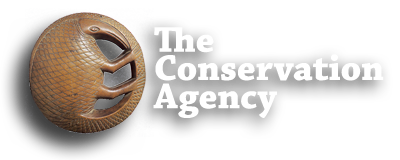The Conservation Agency began field work in The People’s Republic of China in 1980, teaming up with the Guangdong Institute of Entomology and South China’s premier ornithologist, Dr. Liao Wei-Ping. We have sponsored his work and travel in the United States, Canada, and the West Indies, as well as in his own country. Our work in China has taken us into the Sichuan Himalayas, Yunnan’s Xishuangbanna, Hainan Island, and even to the Great Wall. We are supporting the work of Chinese students in U.S. Universities. |
 Significant ongoing research has continued to draw us to the islands of the South China Sea. Here we have discovered many new populations, several new species of land vertebrates, and have documented life histories of threatened species such as Romer’s frog, white-headed blindsnake, and the Chinese pangolin (a scaly ant-eating mammal). We have concentrated efforts on islands in the South China Sea including the geologically ancient island of Nan Ao, in far eastern Guangdong Province, China. On Nan Ao we discovered many populations of species previously known only from inland, upland, and central China. Often these isolated Nan Ao populations are replaced by more tropical relatives on the adjacent mainland. This pattern, dubbed “Austro-boreal disjunction”, is strikingly like that observed in species or subspecies found in the Florida Keys and then again in northern Florida or Georgia. Austro-boreal disjunction has become a topic of great interest in biogeography. |
 We have forged strong ties with Universitas Sam Ratulangi in Sulawesi, Indonesia, and Silliman University in the Philippines. Our expeditions to the Far Moluccas and Typhoon Islands in these countries have resulted in the discovery of three new species of flying dragons (Draco lizards) and we gave gathered a great deal of information about rare and little-known species, such as the anoa (a tiny forest ox), Jelesma’s gecko, and the Sulawesi black racer. |
 Hemlock Woolly Adelgid. This species, called “HWA”, is a tiny aphid-like bug that parasitizes hemlock trees. It is native to Asia and was accidentally introduced to the vicinity of Richmond, Virginia, about 1951. It has spread north and south and is a major killer of our hemlocks. Hemlock forests are a critical habitat for many eastern American species: The conservation implications of HWA pestilence are dire. |
 Beginning in 2005, in cooperation with the USDA Forest Service, a team of volunteers from TCA, led by senior research scientist Dr. Wenhua Lu, began the search for HWA predators in China. There, the HWA occurs but seems well controlled. Many of the most voracious HWA predators are beetles. Our search led us to the mountains of Guangdong and Hunan Provinces, and on into the high Himalayas of Yunnan, Sichuan, and Tibet. In pursuit of biocontrol species for HWA we dodged floods and landslides and encountered wildlife from takin (a sort of ox-like “goat-antelope”) to giant pandas. We also got more than a dozen excellent candidate species of HWA predators. We hope some will soon solve the problem. Beginning in 2005, in cooperation with the USDA Forest Service, a team of volunteers from TCA, led by senior research scientist Dr. Wenhua Lu, began the search for HWA predators in China. There, the HWA occurs but seems well controlled. Many of the most voracious HWA predators are beetles. Our search led us to the mountains of Guangdong and Hunan Provinces, and on into the high Himalayas of Yunnan, Sichuan, and Tibet. In pursuit of biocontrol species for HWA we dodged floods and landslides and encountered wildlife from takin (a sort of ox-like “goat-antelope”) to giant pandas. We also got more than a dozen excellent candidate species of HWA predators. We hope some will soon solve the problem. |


